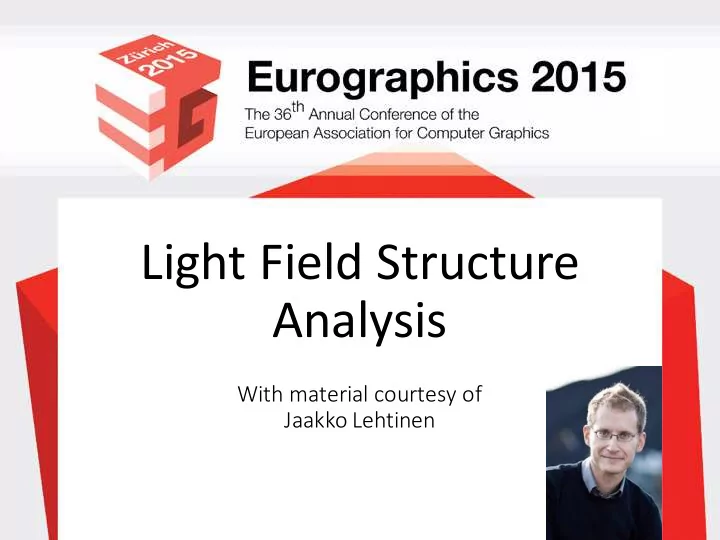

Light ¡Field ¡Structure ¡ Analysis With ¡material ¡courtesy ¡of ¡ Jaakko ¡Lehtinen
Key ¡observation • Light ¡rays ¡are ¡ highly ¡coherent − Rays ¡originating ¡from ¡same ¡surface ¡point ¡vary ¡smoothly ¡over ¡ angle • Represent ¡light ¡rays ¡in ¡ light ¡field ¡parameterization − Rays ¡correspond ¡to ¡points ¡in ¡a ¡4D ¡position-‑direction ¡space • Exploit ¡coherent, ¡ anisotropic ¡structure ¡of ¡light ¡fields 2
Motion ¡blur ¡and ¡depth ¡of ¡field • Requires ¡lots ¡of ¡samples 5D ¡integration: ¡2D ¡pixels, ¡2D ¡aperture, ¡1D ¡time 3
Depth ¡of ¡field ¡(defocus ¡blur) 4
Depth ¡of ¡field ¡(defocus ¡blur) 5
Depth ¡of ¡field ¡(defocus ¡blur) 6
Light ¡field ¡parameterization u x 7
Anisotropy Slopes ¡depend ¡on ¡depth! 8
Defocus ¡blur: ¡integration ¡over ¡lens 9
Naive ¡approach One ¡pixel 10
Exploiting ¡anisotropy • Input: ¡sparse ¡sampling 11
Exploiting ¡anisotropy • Input: ¡sparse ¡sampling • Upsampling − Extrapolation ¡along ¡ known ¡slopes 12
Exploiting ¡anisotropy • Input: ¡sparse ¡sampling • Upsampling − Extrapolation ¡along ¡ known ¡slopes • Core ¡challenge: ¡visibility 13
Exploiting ¡anisotropy • Input: ¡sparse ¡sampling • Upsampling − Extrapolation ¡along ¡ known ¡slopes • Core ¡challenge: ¡visibility • Visibility ¡events ¡produce ¡ ¡ intersections − Detect ¡by ¡locally ¡ triangulating ¡foreground ¡ samples 14
Summary • Input: ¡sparse ¡sampling • Upsampling − Extrapolation ¡along ¡ known ¡slopes − Resolve ¡visibility • For ¡each ¡pixel, ¡usual ¡ Monte ¡Carlo ¡integration ¡ of ¡upsampled ¡data 15
Results ¡(depth ¡of ¡field, ¡motion ¡blur) 16
Results ¡(depth ¡of ¡field, ¡motion ¡blur) 17
Extension ¡to ¡indirect ¡illumination • Challenge : ¡at ¡each ¡ pixel, ¡compute ¡ incident ¡indirect ¡ illumination ¡over ¡ hemisphere ¡ 18
Extension ¡to ¡indirect ¡illumination • Challenge : ¡at ¡each ¡ pixel, ¡compute ¡ incident ¡indirect ¡ illumination ¡over ¡ hemisphere ¡ • Key ¡idea : ¡interpolate ¡ incident ¡rays ¡from ¡ sparsely ¡sampled, ¡ scattered ¡ray ¡ segments 19
Light ¡field ¡parameterization • Represent ¡incident ¡ rays ¡using ¡light ¡field ¡ parameterization 20
Approach • Input: ¡path ¡tracing ¡ with ¡sparse ¡samples • Store ¡path ¡segments for ¡indirect ¡ illumination • Query ¡incident ¡ray ¡ by ¡interpolating ¡in ¡ light-‑field ¡ parameterization 21
Interpolation • Reproject ¡input ¡sample ¡ rays ¡into ¡light ¡field ¡ parameterization ¡at ¡ query ¡location • Interpolate ¡at ¡query ¡ ray • Challenges − Visibility − Non-‑diffuse ¡surfaces 22
Visibility • Detect ¡occlusions ¡using ¡ a ¡coarse ¡point-‑based ¡ scene ¡representation 23
Glossy ¡surfaces • Store ¡glossy ¡BRDF ¡ lobe • Use ¡as ¡weight ¡when ¡ extrapolating ¡sample 24
Results: ¡diffuse ¡indirect ¡illumination Input ¡8spp Reconstruction PBRT ¡512spp 25
Results: ¡ambient ¡occlusion Input ¡4spp Reconstruction 26
Conclusions • Light ¡field ¡parameterization ¡reveals ¡anisotropic ¡ structure ¡of ¡incident ¡light • Convenient ¡representation ¡for ¡upsampling ¡and ¡ interpolation − Easy ¡to ¡preserve ¡light ¡field ¡structure • Good ¡results ¡from ¡very ¡sparse ¡input • Challenges − Visibility − Glossy ¡surfaces − Memory ¡requirements 27
Recommend
More recommend